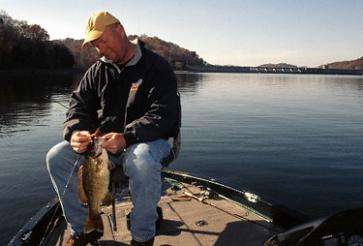
It’s just about time for one of my favorite fishing techniques to get hot. Of course my very favorite fishing technique is whatever I used to catch the last bass, but I’ve got to admit that I love it when the weather starts to get really cool and the water temperature starts to dip into the mid-50s because that’s when I begin thinking about the float and fly.
If you haven’t already tried the float and fly, and you’re a smallmouth angler, you’re really missing out. It’s just about the most fun you can have when you’re on the water and it’s cold. The float and fly technique is fun, and it’s extremely effective once the water temperature drops below about 55 degrees.
Around most of the smallmouth world we’re not quite there, but it’s coming, and this is a good opportunity to talk about the float and fly so you can get geared up.
At its core, float and fly fishing is very simple. The smallmouth (it works on other bass, too) are suspended and lethargic (that water’s getting cold!) so you want to suspend your lure at the same depth as the baitfish (or maybe a little deeper) to get their attention. Fast moving lures won’t work because the fish are too sluggish to chase after them. Bottom bumping lures won’t work because they’re below the bass. A deep diving suspending jerkbait might do the trick, but they’re a lot bigger than most of the food the smallmouth are eating.
The answer is to suspend a tiny jig (usually 1/16-ounce) under a cork float. No big deal, right? We all did that when we were growing up and fishing for bluegill on creeks and farm ponds.
Well, the problem is that while we caught the bluegill on worms and crickets that were suspended just a few inches or feet below the cork, these smallmouth are much deeper and targeting baitfish that may be 12 or 15 feet down. That means we need some specialized equipment to catch them.
And that’s where a good float and fly rod comes in. Lots of companies make them (my favorites are made by Bass Pro Shops and GLoomis, but there are other good ones, too), and they come in lengths from 7 1/2 feet to 12 feet long. The longer the rod you choose, the longer the leader (distance between the cork and the jig) you can throw, but the heavier the rod will be. Those ounces can seem like pounds at the end of the day, so I do most of my float and fly fishing with an 8- to 9-foot rod. It’s long enough to handle all but the longest leaders and short enough that it’s still very light.
Since young-of-the-year shad tend to be pretty small at this time of year, you’re going to want to use small jigs to imitate them. That’s where a little 1/16-ounce jig comes in. It’s the “fly” in the float and fly. The “float” is the cork.
It may look like a crappie jig, but a good float and fly jig is much different. For one thing, it’s got a much better and bigger hook in it. You need a real bass-sized hook if you’re going to catch big smallmouth. For another thing, it’s got to look like a shad, so it needs to come in more sophisticated colors and patterns than the average crappie jig.
We’ll talk more about the float and fly and why it’s so effective very soon. For now, just think about how you can utilize the technique on your waters. And if you’re already a float and fly veteran, feel free to e-mail me with comments or questions.
Until next time, if you have any questions or comments, I’d love to hear from you. Please e-mail me atStephen@thesmallmouthguru.com.





